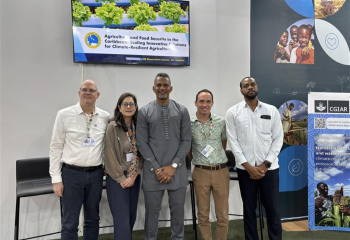CDB Conducts Training Workshop, Helps Boost Aquaculture Sector in Guyana
The Caribbean Development Bank (CDB) is supporting the advancement of the aquaculture sector in Guyana, as the Ministry of Agriculture seeks to diversify the country' agriculture industry. From August 17 to 21, 2015, CDB conducted a workshop on aquaculture farm management techniques for Ministry employees—a training initiative that aims to revitalise the sector and improve the livelihoods of aquaculture entrepreneurs.
Participants during the workshop on aquaculture farm management techniques in Guyana.
Fifteen Extension Officers assigned to the aquaculture sector participated in the Aquaculture Farm Management Techniques Training Workshop, which CDB presented through its Technical Cooperation Division and Caribbean Technological Consultancy Services (CTCS) Network, in collaboration with the Fisheries Department of the Ministry of Agriculture.
“With transfer of learning to the work environment, this project is expected to contribute to increases in the number of aquaculture farms, employment, exports, and micro, small and medium enterprises' (MSME) business performance. This will ultimately improve the livelihoods of small entrepreneurs within the Aquaculture industry, and increase the industry' overall contribution to agriculture and Guyana' GDP," said Edward Greene, Division Chief of CDB' Technical Cooperation Division.
Aquaculture production occupies about 3,000 hectares of space across Guyana, with approximately 52 farms currently operating within the sector throughout eight of the 10 administrative Regions of Guyana. Despite cases in which the production of fingerlings has more than quadrupled over a five-year period, the number of aquaculture farms is dwindling.
“As a Government, we are looking to further promote this industry by looking at ways to promote the production of commercial species such as tambaqui and tilapia rearing. Training is important- because for us to be successful we need our fish farmers not be not only well organized but to also be well trained. There is an ever growing market regionally and internationally and for us to tap into that market we have to be well organized," said Permanent Secretary of the Ministry of Agriculture, Mr. George Jervis.
The sector continues to face challenges surrounding the supply of feed; export-readiness of farmed products; the production of fingerlings for new or emerging species of fish; and the lack of human resource capacity. Combined, these issues contributed to a 47 percent decrease in production in 2011 and a further 15 percent decrease in production in 2012. In addition, the number of farms operating within the sector between 2008 and 2013 declined by 73 percent—from 196 to 52.
Fifteen Extension Officers assigned to the aquaculture sector participated in the Aquaculture Farm Management Techniques Training Workshop.
Of the 52 farms in operation, women manage six of them. This data presents the opportunity for CDB to identify the possible gender-related issues within the aquaculture sector and determine how these can be addressed to exploit the full potential of productive resources in Guyana and, ensure that women benefit from the growth potential of the sector.
“As a result of this Project, an analysis of the gender-related issues in the sector is being conducted and recommendations for addressing these issues and constraints will be presented. The information harvested from this exercise will better position CDB and other development agencies, government agencies, and non-governmental organisations to design technical assistance interventions that will seek to address the issues and challenges related to gender within the sector," said Mr. Greene.
The workshop aligns with CDB' strategic objective of supporting inclusive growth and sustainable development, and the Bank' corporate priorities of promoting private sector development leading to the enhanced viability of MSMEs, and supporting agriculture and rural development.

